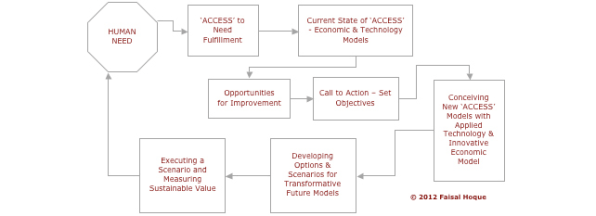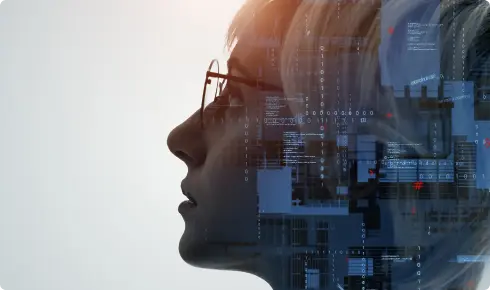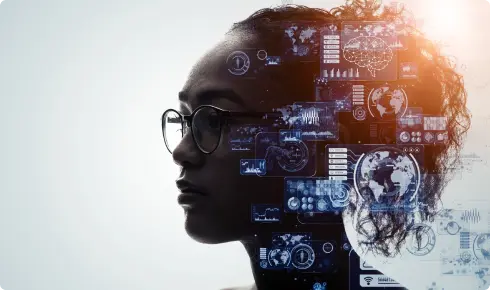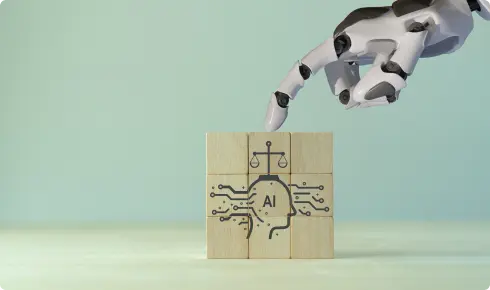Transformation can be modeled, documented, and implemented as a total game-changing process. Here’s how to get it started.
BY FAISAL HOQUE
The psychologist Abraham Maslow posited that humans must satisfy basic needs for food, water, and shelter in order to evolve to our highest potential. To these, today, we must include access to some kind of enabling technology, which in turn unleashes creativity and innovation in a sustainable environment.
Globalization and the transformative power of access to enabling technologies has made the prevailing cause-and-effect narrowness of traditional economic theory outdated, and more enlightened views must be applied to solve the complex issues we globally face today.
Developing nations’ growth and development in the 20th century were once measured in decades. Now, with the deployment of technologies, they are able to transform themselves in just months or years into productive members of the international commercial society.
Consider the following examples:
Photovoltaic power cells were invented in the U.S., but China is now the world’s largest producer. China is setting a green, sustainable-energy example for the world in planning to increase its use of solar power fivefold, to 20 gigawatts, by the year 2020. Solar applications are on the rise. Toyota’s innovative application of integrated solar cells in the Prius’ roof powers air conditioning, keeping the interior cool when the car sits outside on hot days. China’s transformative policy of supporting green power grows ever stronger. The implications of becoming a clean-energy producing superpower have yet to be fully analyzed.
In Mexico, Cemex Corporation, the country’s largest multinational, has made profitable customers out of millions of the world’s poorest families, organizing them to purchase its cement and other products to build or remodel simple homes. Cemex developed the Patrimonio Hoy strategy (“patrimony today,” i.e., creating something of value for use today) based on its seven sustainable objectives, then set out, first in Mexico, to transform the less fortunate of the third world by offering microcredit and guidance for how to improve, or build new, homes for themselves. Patrimonio Hoy has given access to better homes for 120,000 of Mexico’s poorest families, while giving women new careers as home consultants and putting innumerable masons and builders to work. Cemex is working to reduce emissions and energy consumption: In Mexico, for example, 25% of its electrical energy comes from a wind farm. The Patrimonio Hoyprogram has now gone global.
In Tanzania and other African countries, a nonprofit organization called KickStart sells technologies, such as its Super-MoneyMaker irrigation pump, to farmers. This technology lifts water uphill into fields, enabling farmers to produce more crops per season and grow higher value crops. Farmers using the pumps have increased their income tenfold, from $110 to $1,100 a year, lifting them out of poverty and improving the education and healthcare of their families. KickStart insists on selling the pumps, not giving them away, and has established for-profit supply chains from manufacturer to farmer. The program is a great success: Some 45,000 pumps are in use by poor farmers; 29,000 new waged jobs have been created; and the pumps have generated some $37 million per year, both in new profits and wages.
Transformations such as these are occurring around the globe at an ever accelerating pace, from Cambodia to the Dominican Republic to Madagascar, in countries large and small, from third world to first world. The opportunity to demonstrate new, powerful transformations like these has never been greater.
Steps to Sustainable Transformation
The term transformation originated with biology and genetics. In short, biological transformation refers to the introduction of something organic and systemic that can change the essential nature of a cell. Its purpose is to invoke change. The transformative process is nearly identical for every organization today: introduce a new goal, add the variable, and transform it into creativity and innovation.
Transformation is driven by an acknowledged need to grow and change, followed by thinking differently about the old ways and means.
It can be modeled, documented and implemented as a total game-changing process. At a high-level, these 7 steps can be defined as:

1. Human nature is driven by wants and/or needs
2. We develop strategies to evolve tactics to turn those wants and needs into goals
3. With tactics in place, we can formulate a plan, or call to action to achieve the goals
4. The plan, or call to action, involves setting personal or business objectivesand determining the most appropriate technologies with which to implement them
5. When the business objectives are combined successfully with the appropriate technologies, the result is convergence, the seamless merging of both to attain goals
6. Convergence makes it possible to create a viable economic model applying enabling technologies, essential in the process of satisfying the wants or needs
7. Transformation occurs when the individual or enterprise has successfully embarked upon on the new course to achieve its goals
Those completing this process are now positioned not just to survive, but to progress and thrive. The process is repeatable–in fact, it loops–continually transforming actions through the use of powerful enabling technologies into creative, innovative, and sustainable goals and outcomes.
Change, Innovation, and Progress
Transformation begins within an organization because there is a perceived need to grow and change:
- There may be institutional stagnation.
- Employees may no longer feel motivated.
- There may be a profound, often unspoken sense in the community that the institution must grow in new, innovative ways.
- There may be an outside threat in the form of competition, unsustainable expenses, or a hostile takeover.
In short, the need for transformation can come from as many identifiable factors as from hidden ones. For the institution to transform itself and succeed, the transformative influence must first permeate internally, blossom into a new spirit of creativity and innovation, then diffuse throughout the internal and external socio-economic culture and beyond, because we live in a global economy where the slightest reverberations often have a powerful ripple effect.
Sustainable transformation is not a business function; it is a fundamental systemic shift in the individual or the institution and their worldview. It is the core concept in a process that is understood and managed step-by-step to the ultimate goal: the ability to change and innovate with changing times.
Copyright © 2017 by Faisal Hoque. All rights reserved.
Read the original article @FastCompany.















